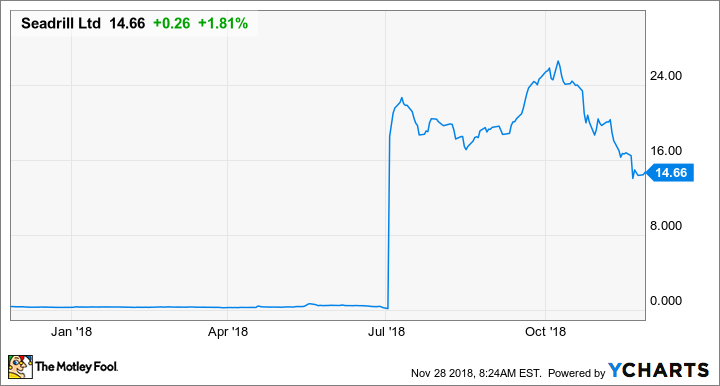Should Seadrill's First Post-Bankruptcy Earnings Entice You Into Buying Its Stock?
Seadrill (NYSE: SDRL) was once the darling of the offshore oil and gas industry, with a fleet of modern rigs to lease, and several more under construction to support further growth. Then crude oil prices started to crash, and the narrative around the company changed from "industry disruptor" to "debt-laden business with more cash obligations than it can pay." It went into Chapter 11 bankruptcy in September 2017, and reemerged from a restructuring in July. And on Tuesday, investors for the first time got to see a set of that revived Seadrill's quarterly results.
Now that the drilling giant has a more secure balance sheet, should investors consider buying Seadrill stock? Let's take a look at the company's most recent financials, and consider what management had to say.
By the numbers
This was Seadrill's first earnings report since it reemerged from bankruptcy, so there is no directly applicable year-ago quarter to which we can compare its numbers. But for some context, let's stack up the numbers from the most recent quarter next to the results from the first nine months of 2018, and the same period in 2017.
Metric | Q3 2018 | First 9 months of 2018 | First 9 months of 2017 |
|---|---|---|---|
Revenue | $249 million | $961 million | $1.66 billion |
Operating income | ($106 million) | ($719 million) | ($47 million) |
Net income | ($245 million) | ($4.10 billion) | ($413 million) |
Diluted EPS | ($2.40) | ($10.11) | ($0.61) |
Data source: Seadrill Ltd earnings release. EPS= earnings per share.
It's pretty much impossible to do an apples-to-apples comparison of Seadrill's results because it has been completely restructured, and many of its financials have been reset. For example, it wrote down about $6.64 billion in assets as part of the bankruptcy proceedings, a reflection of how far management thinks the future value of its current fleet has deteriorated.
The one thing, though, that remained relatively consistent is the company's fleet status. As of the end of Q3, 58% of its fleet was utilized. Management also went out of its way to note that economic utilization (the percentage of days those rigs under contract were working and not undergoing maintenance) was 98%, which is good because it means it's getting the most out of its contracted fleet.
From the beginning of the quarter to the day it released earnings, Seadrill was able to secure eight contract extensions and exercised options on its rigs. These additional contracted days increased the company's backlog by $296 million to a total of $2.1 billion.

Image source: Getty Images.
What management had to say
In the press release, Seadrill CEO Anton Dibowitz mostly stuck to the "we're a stronger company" script that you would expect from the leader of any business reemerging from bankruptcy. There was one nugget in that statement that's particularly worth considering, though (bolded emphasis my own):
Having restructured our business, we are now well positioned to capitalize on the recovery. The combination of a strong cash position, no near-term amortization payments or debt maturities and light financial covenants alongside a large modern fleet and continued focus on cost reduction will ensure we remain competitive.
The fundamentals for our industry remain strong and there are improving signs through increased contracting activity, additional supply leaving the market and industry consolidation which should lead to better pricing in the future. We are already starting to see rate improvements for contracts starting in 2019/20.
We remain disciplined in our approach to contracting and will not be drawn into long-term contracts at low day-rates given our financial flexibility.
That last point is noteworthy because it shows that management is eschewing the typical strategy for contracting rigs. Typically, businesses in this industry view long-term contracts as preferable since they give more clarity on future revenue. A decision to stick to short-term contracts means that management anticipates an increase in offshore drilling that will allow it to charge higher day rates.
An investment-worthy stock post-bankruptcy?
I have to admit my own bias first. I owned Seadrill stock pre-bankruptcy, and lost a lot of money because I thought the company could turn things around. I was wrong, and will likely hold a grudge against Seadrill even though not selling was my own fault. I didn't let myself see the issues staring me in the face.
Management has said it expects Q4 to be worse than Q3, and most of the statements in its press release imply that the current period of weakness in the offshore drilling business could last a couple more years. If that is the case, then Seadrill could report several more quarters of weak results. While it may be worth buying now and waiting a few years for a payoff, investors who do so should be prepared for things to get worse for the company before they get better.
More From The Motley Fool
Tyler Crowe has no position in any of the stocks mentioned. The Motley Fool has no position in any of the stocks mentioned. The Motley Fool has a disclosure policy.

 Yahoo Finance
Yahoo Finance 
